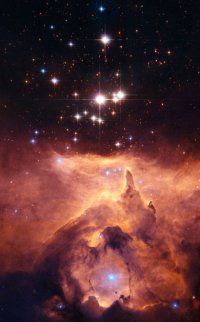Hubble Resolves Massive Star System Pismis 24-1 [heic0619]
12 December 2006
High-resolution observations from Hubble have shed light on the real mass of a star previously believed to be amongst the heaviest known in our Milky Way. Originally, the mass of the star was thought to be an incredible 200-300 solar masses, but turned out to be only 100 solar masses when the star was resolved to be part of a multiple star system.
 |
|
Multiple massive star system Pismis 24-1 in the emission nebula NGC 6357 |
One of the top candidates for being the most massive star in the Milky Way was, until now, Pismis 24-1, a bright young star that lies in the core of the small open star cluster Pismis 24 (the bright stars in this Hubble image) about 8000 light-years away from Earth. Pismis 24-1 was thought to have an incredibly large mass of 200 to 300 solar masses. This would have made it by far the most massive known star in our Galaxy the Milky Way. New NASA/ESA Hubble measurements of the star, have, however, resolved Pismis 24-1 into two separate stars of around 100 solar masses each.
These impressive observations, performed by a team of astronomers led by Jesús Maíz Apellániz of the Instituto de Astrofísica de Andalucía in Spain, were obtained with the highest-resolution optical-imaging instrument aboard Hubble - the High Resolution Channel (HRC) of the Advanced Camera for Surveys (ACS).
The star cluster Pismis 24 lies in the core of the large emission nebula NGC 6357 that extends one degree on the sky in the direction of the Sagittarius constellation. Part of the nebula is ionised by the youngest (bluest) heavy stars in Pismis 24. The intense ultraviolet radiation from the blazing stars heats the gas surrounding the cluster and creates a bubble in NGC 6357.
The team also managed to determine the mass of another massive star in the star cluster Pismis 24: Pismis 24-17. Its mass is around 100 times that of our Sun and brings the total number of heavy stars within this cluster to at least three, which is a very rare occurrence for a cluster this small: in our Milky Way, for every star with 65 solar masses or more that is born, another 18 000 stars of ~1 solar-mass are produced. Furthermore, since a 65 solar-mass star lives for only 3 million years while a solar mass star can live for more than 3000 times that long, there are actually millions of solar-mass stars for each very massive star.
The scrutiny of Pismis 24-1 still continues: ground-based observations indicate that Pismis 24-1 could even be a triple star system. Although each of the three stars would then only average at 70 solar masses, they would still make it to the top twenty-five of most massive stars in our Galaxy, but only for a few million years as they would be sure to end their lives as supernovae and then turn into black holes.
Jesús Maíz Apellániz's team plans to study the Pismis 24 cluster further and to look at other systems in the hope of establishing just how massive a star can be.
Massive stars can be the precursors of either black holes or neutron stars, formed in the supernovae that are the final spectacular flaring of a collapsing massive star and the main sources of the heavy elements in the Universe. By studying massive stars astronomers gain a deeper insight into our current understanding of black holes, supernova explosions and the chemical composition of the Universe.
The results of this study were presented at the Massive Stars Workshop in Argentina, in December 2006.
Notes for editors
The Hubble Space Telescope is a project of international cooperation between ESA and NASA.
Credit: NASA, ESA and Jesús Maíz Apellániz (Instituto de astrofísica de Andalucía, Spain)
The team members are: Jesús Maíz Apellániz (Instituto de astrofísica de Andalucía, Spain), Nolan R. Walborn, Edmund P. Nelan (Space Telescope Science Institute, USA), Nidia Morrell (Las Campanas Observatory, Chile), and Virpi Niemela (Universidad de La Plata, Argentina).
Contacts
Jesús Maíz Apellániz
Instituto de astrofísica de Andalucía, Spain
Tel: +34-958-230-529
E-mail: jmaiz iaa.es
iaa.es
Lars Lindberg Christensen
Hubble/ESA, Garching, Germany
Tel: +49-89-3200-6306
Cellular: +49-173-3872-621
E-mail: lars eso.org
eso.org
Ray Villard
Space Telescope Science Institute, Baltimore, USA
Tel: +1-410-338-4514
E-mail: villard stsci.edu
stsci.edu

